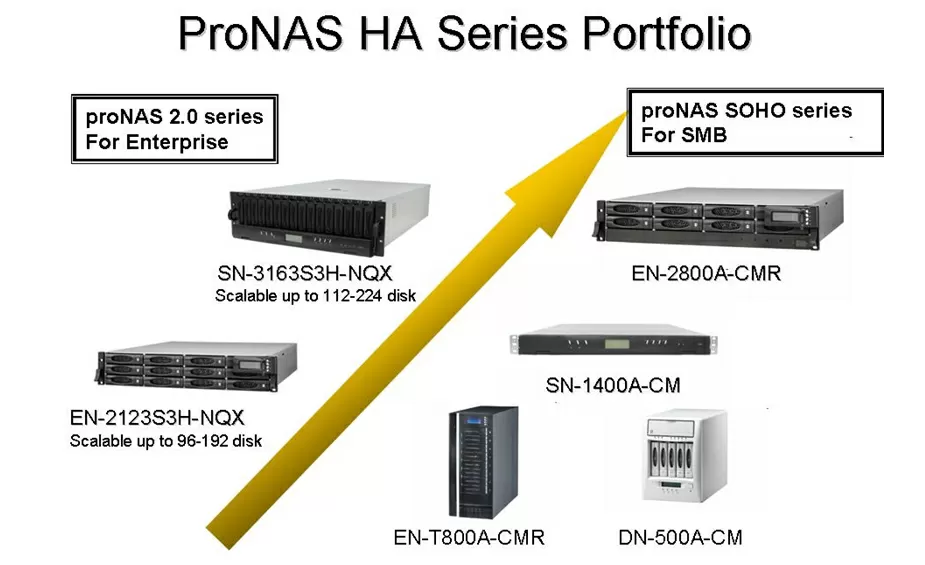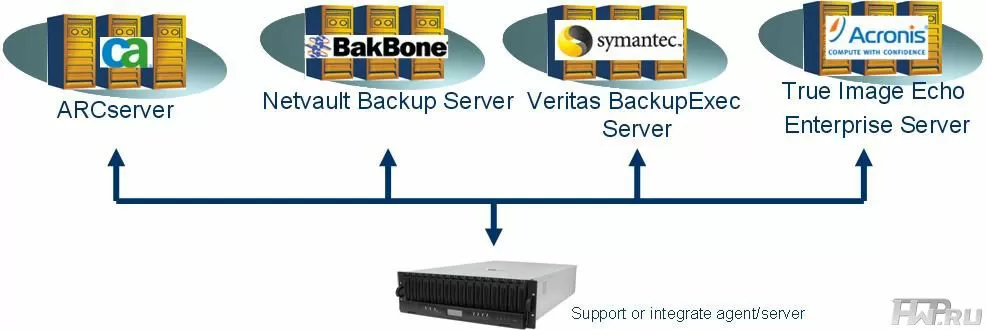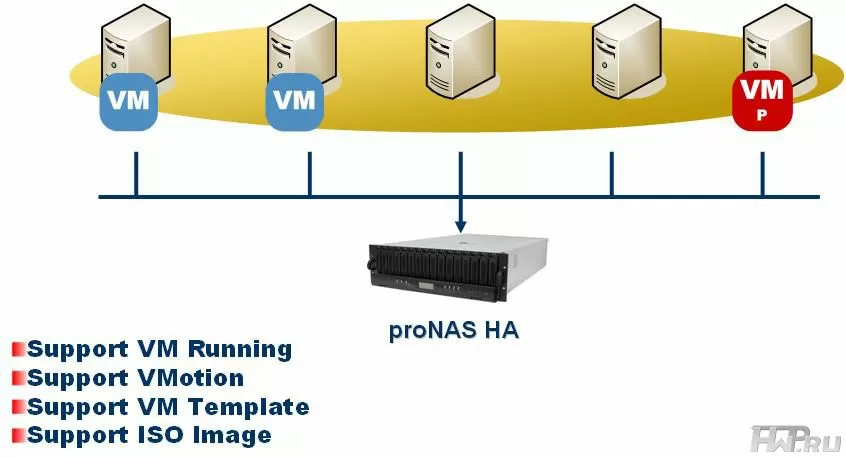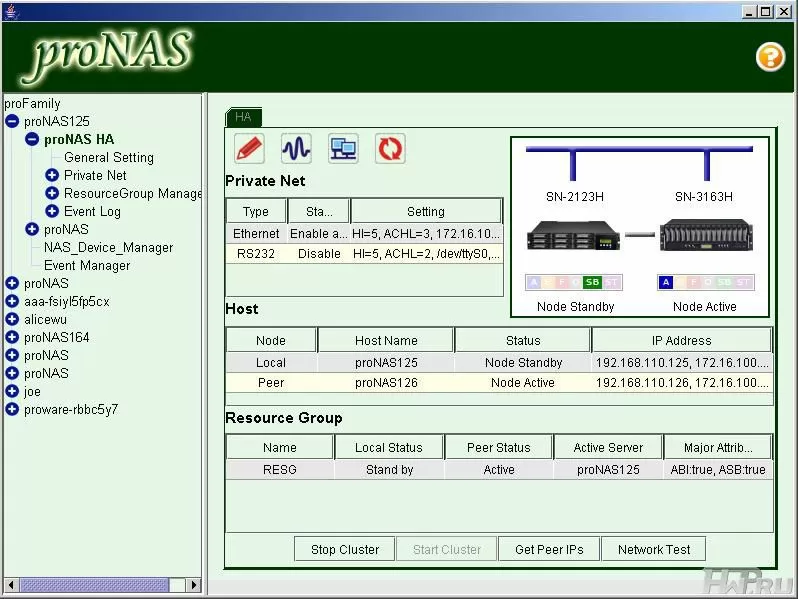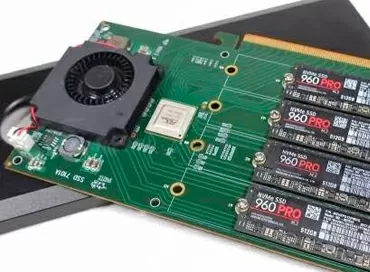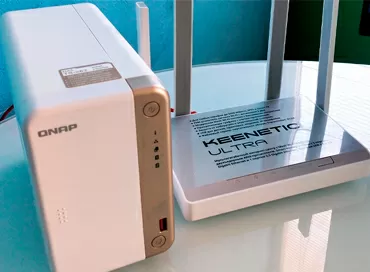Disk arrays and NAS servers ProWare
Storage systems is the memory of supercomputers and key servers, the memory of entire networks, enterprises and organizations. Without reliable disk arrays, even the most powerful and reliable enterprise-level server will not ensure data safety, which means that normal operation is simply impossible without storage. For entry-level systems, there are small arrays that are integrated directly into the platform, but really serious solutions require dedicated devices. A good example of such arrays and servers is the line of ProWare Technology Corp, which has been in the storage market for over 17 years. For more than 8 years, the company's engineers have been developing and manufacturing NAS servers and Linux-based operating systems
ProWare Technology presents a new range of disk arrays and NAS-servers on the Russian market. thanks to which you can build a high-performance professional solution of various complexity levels. Let's see in detail what capabilities these devices provide.
Lineup
As a matter of fact, it will not be possible to cover the entire model range of ProWare equipment within the framework of one small review - the number of different models and configurations is very large, since solutions are provided with different types of interfaces, different capacities and, of course, differing in their architecture ... Globally, the ProWare line of systems is divided into the EPICa, Simbolo and proNAS series. From the affordable, reliable and relatively simple Simbolo to the powerful infrastructure proNAS, it comes in Tower and Rack versions with SCSI, Fiber Channel, Ethernet, iSCSI and SAS host interfaces. With this choice, for any task, you can choose an option that is optimal from all points of view. Before going directly to the hardware part, let us recall the basic information about the interfaces used by ProWare in their systems.
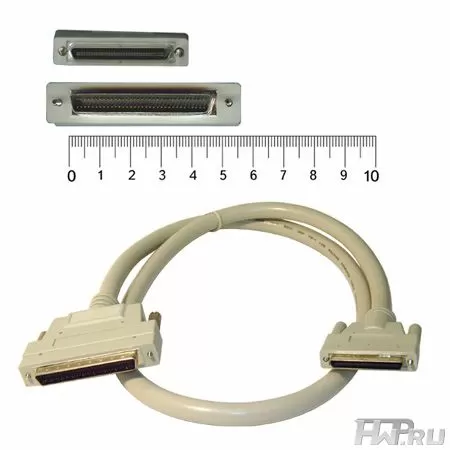
SCSI (Small Computer System Interface) - half duplex parallel interface. In modern storage systems, it is most often represented by the SCSI connector VHDCI 68 or HD 68 pin
- Data transfer rate - up to 320 MB/sec
- Maximum cable length - 3 meters
iSCSI (Internet Small Computer System Interface) - a variant of SCSI, which translates over TCP, thereby increasing the usability, compared to conventional SCSI devices, this the interface is widely used for accessing storage systems, since it allows operation on a relatively inexpensive and flexible management basis (based on an IP network, for example, 1G or 10G Ethernet).
- Data transfer rate - 1 Gbps, (100 Megabytes per second) or 10 Gbps (1 Gigabytes per second)
- Ability to use an existing 1G or 10G local network.
The iSCSI interface is usually represented by an external RJ-45 connector for connecting to a 1GEthernet network
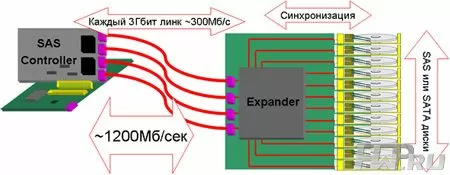
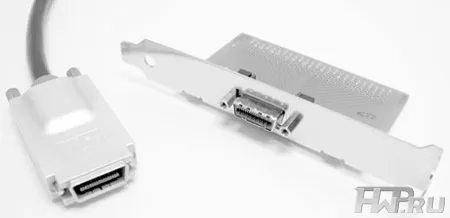
External SAS (Serial Attached SCSI) is a new generation of SCSI command interface, but unlike the original SCSI with serial rather than parallel data transfer. Used to connect disk arrays of other external drives.
- Data transfer rates - up to 1200 Mb/s (SAS interface allows multiple ports to be bundled together into 'wide' connections. They give a total bandwidth of 1x, 2x, 3x, 4x, 3Gb/s each)
- The maximum cable length is 5 meters
Fiber Channel , & mdash; it is a standard for serial (fiber optic) connections designed for high-speed, two-way point-to-point communications between servers, drives, workstations and (very importantly) hubs and switches.
- Data transfer rates per channel - 1 Gbps, 2 Gbps, 4 Gbps and 8 Gbps (100 MB/s, 200 MB/s, 400 MB/s and 800 MB/s)
- Works in full-duplex mode (two optical cables are used to connect devices, each of which works in one direction. With a balanced set of read/write operations, the data exchange rate doubles)
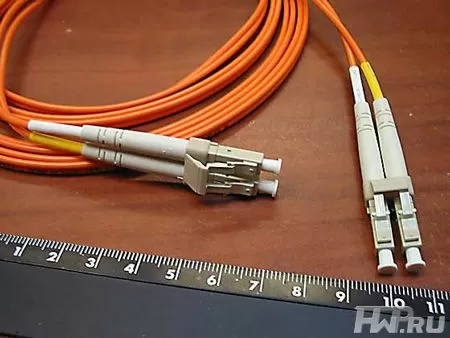
Range of work - up to 50 kilometers. The physical link is usually a 50/125 micron and 62.5/125 micron fiber optic cable with LC connectors.
We will also provide brief information about the types of storage system connection:
NAS (Network Attached Storage) is a network attached hard disk storage system directly attached to the network, with its own network address and file system. Works on the same network with computers and is a computer with a disk array accessible to other computers on the network. It is possible to combine several such computers into a single system. NAS provides high reliability of data storage, ease of access and administration, and is easy to scale.
DAS (Direct Attached Storage) is a storage system attached directly to the server or working via SCSI or SAS. Provides maximum performance for this server or PC, but cannot share resources with other servers on the network.
SAN (Storage Area Network) - storage area network. With this storage architecture, disk arrays are connected to servers on the network in such a way that they are identified by the operating systems of the servers as local resources. This allows for high speed and reliable data storage for multiple servers on the network.
Typical SAN infrastructure is Fiber Channel or iSCSI using dedicated hardware or software controllers.
The SAN consists of :
- The communication infrastructure that provides the physical link between the elements of the SAN
- Storage Devices - Storage
- Servers or Workstations.
Simbolo Series
The most affordable and, if I may say so in relation to storage systems (data storage systems), are the most popular models of the Simbolo series. They were created in order to combine the following principles: reliability, performance, budget. We can say that we succeeded in fulfilling the task - the Simbolo family allows you to start working with real "adult" storage systems with minimal investment of money and time.
From the technical point of view, the distinguishing feature of the Simbolo series from other systems is the use of ARCA ARC-Series RAID controller. These controllers have proven their worth - they allow you to increase the reliability of data storage using RAID 6, in this case, data will not be lost, even if 2 disks in the array fail at the same time.

The very name of the series - Simbolo - translates as "Symbol", and these products have truly become iconic since their inception in 2002. Firstly, the positioning of this series made storage systems accessible, and secondly, the original design and emphasized individuality of Simbolo make us reconsider the view on the disk array, this is already a product for a wide range of consumers, and not only for obsessed enthusiasts and scientists, which means a device user-friendly, convenient and easy to work with.
In particular, there is a Smart-LCD function, thanks to which it is possible to operate from the LCD panel (Menu-driven), in addition, the environmental controller ENC (Environmental Notice Controller) is applied. All models support RAID ADG (RAID 6) according to R.O.C. Today, there are 23 models in the Simbolo series, all of them are rack-mountable and range in size from 1U to 3U and contain from 4 to 16 hard drives. With Simbolo you can build solutions for DAS, NAS, FC and IP SAN infrastructure. Among the ProWare Simbolo disk arrays, there are models with the following interfaces: SCSI-PATA/SATA, FC-SAS/SATA, SAS-SAS/SATA, iSCSI-SAS/SATA and SATA/SAS NAS, the systems' own memory can be expanded up to 2 GB, this allows building reliable fault-tolerant solutions based on Simbolo even for large enterprises.
EPICa Series
Perhaps the most versatile and popular is the family of mid-level storage systems - ProWare EPICa. This series has a significant and successful history, primarily embodying innovative ProWare technologies.
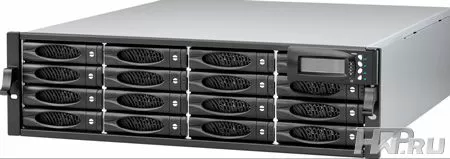
Accordingly, it comes as no surprise that the series is quite numerous, now it has 28 models, 12 of which have SAS host interface, 7 models use Fiber Channel and 6 models use SCSI. Another model provides iSCSI operation and two models with USB/eSATA host interface. Accordingly, there are options for every taste, for every task and for different budgets. Most ProWare EPICA solutions are rack-mountable, ranging from 2U to 4U, but three models are in a pedestal format and do not require a rack. The number of drives can vary from 8 to 42 (!), Most models are equipped with 12 or 16 hard drives.
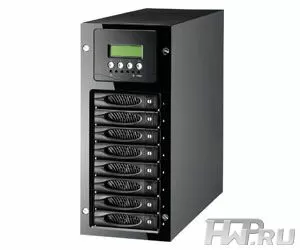
ProWare EPICa disk arrays with FC-SAS/SATA, SAS-SAS/SATA, iSCSI-SAS/SATA and SATA/SAS NAS interfaces and with the possibility of expanding their own memory up to 4 GB are optimal for solutions of the level a medium-sized enterprise or corporation, on their basis DAS, NAS, FC and IP SAN infrastructures are built. The oldest models in the series - the 42-disk EP-4429J/JD-S3A3, EP-4423S/D-F4S3 and EP-4423J/JD-S3S3 were created for application virtualization, video editing and building high-performance SAN configurations. In addition, there is a kind of series-in-series: MiniEPICa.
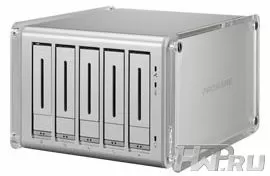
These are compact storage systems designed for just 2, 3 or 5 hard drives - These systems are available in pedestal (tower) design and in 5.25 & rdquo; bays for servers and workstations, have eSATA-to-SATA and SATA-to-SATA interfaces.
proNAS series
Finally, the top series in the ProWare line - proNAS network storage systems. As the name suggests, all products in this group are designed for NAS use. Typically, such solutions are used when building an enterprise infrastructure that requires the use of reliable and scalable file storage with multi-user access.
ProWare NAS systems are represented by three families: proNas SOHO SMB , proNas 2.0 enterprise , proNAS WSS enterprise whose model range makes over 30 models.
proNas SOHO SMB - budget solutions for companies in the SMB sector for 4-8 disks in rack or tower design, with Intel Pentium Dual Core or Core 2 Duo central processors and equipped with a simple and a reliable 32-bit operating system developed by Proware engineers based on Linux - proNAS 2.x. with iSCSI and MS Active Directory support.
proNas 2.0 enterprise and proNAS WSS enterprise - universal (DAS, SAN and NAS in one system), high-performance and scalable enterprise-level systems, from 5 to 16 drives in rack (from 1U to 3U) and pedestal, with Intel Pentium Core 2 Duo CPUs or two Intel Xeon Quad Cores. The RAM of such NAS systems is DDR2 or DDR3 up to 32GB, of course, they are equipped with a hardware RAID controller and have from 2 to 8 Gigabit Ethernet ports or two 10 Gigabit Ethernet ports. Expandable to 224 drives, the solutions are equipped with a 64-bit operating system with a wide range of functions for professional use. This system was developed by Proware engineers based on Linux - proNAS 1.3.x (proNas 2.0 for enterprise series) with iSCSI and MS Active Directory support, there is a possibility of building a cluster solution and other useful features. Also available with Microsoft WUDSS Standard Edition 64 bit (for proNAS WSS enterprise series).
Unlike the vast majority of alternative solutions, the proNAS 2.0 enterprise series uses hardware RAID controllers (cache memory 128-2048MB) and all 3 types of connection are supported: NAS over Gigabit Ethernet or 10 Gthernet, SAN over iSCSI, DAS over SAS or SCSI.
Leading backup software solutions supported:
If necessary, the agents of these products can be integrated into the ProNas Operating System.
ProNas also has support for VMware-based virtual environments:
Also the proNAS line models are divided into 2 groups according to the control interface, the proNAS 1.3.x () and proNAS 2.x systems are used, their main characteristics and differences are summarized in the table:
|
NAS OS |
proNAS 2.x |
proNAS 1.3.x |
|
Core |
2.6.24.3 (32 bit) |
2.6.29.4 (64 bit) |
|
NAS OS update |
Web browser |
Web browser |
|
Hardware RAID Support |
N/A |
Yes |
|
RAID Levels |
0,1,5,6,10 and JBOD |
0,1,3,5,6,0 + 1, JBOD (need to refer RAID controller specification) |
|
Network Client Support |
Windows, Unix/Linux, Macintosh |
Windows, Unix/Linux, Macintosh |
|
Supported protocols |
TCP/IP, DHCP, AFP over TCP/IP, SMB/CIFS, NFS, SNMP, FTP, Telnet, NAT, SSH, NTP, DAAP |
TCP/IP, DHCP, SMB/CIFS, NFS, SNMP, FTP, SFTP, HTTP, Telnet, SSH |
|
Volume Management |
Yes |
Yes |
|
Support for multiple groups |
N/A |
Yes |
|
Online Logic Volume Expansion |
Yes |
Yes |
|
Disk Roaming |
Yes |
Yes |
|
RAID Extensions |
Yes |
Yes |
|
Migrating RAID Levels |
N/A |
Yes |
|
Veritas Backup Exec Agent |
N/A |
Support will be available with update |
|
Backup/Restore Support |
Yes |
Yes |
|
USB Backup |
Yes |
Yes |
|
Remote Backup |
Yes (SMB/NFS) |
Yes (SMB/NFS) |
|
Backing up to tape |
N/A |
Yes |
|
proBackup Support |
N/A |
Yes |
|
Multi-Snapshot Schedule Support |
N/A |
Max. 64 |
|
Replication/Cluster |
N/A |
2 nodes |
|
Rsync (server or client) |
File level (local & amp; remote) |
File level (local & amp; remote) |
|
Duplication |
N/A |
File level (local) |
|
SNMP/MRTG support |
N/A |
Yes |
|
Trucking/load balance/fail over |
Yes |
Yes |
|
DHCP Server |
Yes |
Yes |
|
Monitoring/Control |
Single node |
Multiple nodes |
|
iTunes Server |
Yes |
N/A |
|
Print Server |
Yes |
N/A |
|
BT Downloads |
Yes |
N/A |
|
PHP Server |
Yes |
N/A |
|
MySQL server |
Yes |
N/A |
|
DLNA (UPNP) |
Yes |
N/A |
|
P2P |
Yes |
N/A |
|
WWW Server |
Yes |
N/A |
|
Photo Album |
Yes |
N/A |
|
iSCSI target |
Yes |
Yes |
|
Windows/MAC Client Discover Utility Tool |
Yes |
Yes |
|
Model examples |
DN-500A-CM, SN-1400A-CM, EN-2800A-CM, EN-800A-CM |
SN-2803H-PDC (S5220), EN-2126JS3H-NQX, EN-3166JS3H-NQX, SN-3163S3H-NQX |
Thanks to a wide range of models and a professional and functional operating system, ProWare proNAS network storages can be integrated into any information environment, in addition, they have advanced functionality in terms of data protection. The combination of these qualities makes proNAS enterprise-level solutions.
Fault Tolerant NAS Servers & Solutions
In addition to basic hardware solutions, ProWare also offers ready-made large-scale solutions, such as cluster NAS storage. The use of such systems is justified if unprecedented fault tolerance and high availability are required. ProWare NAS servers, which were mentioned a little earlier, run on their own proNAS operating system and have a built-in function for building a failover cluster, that is, it is a regular built-in service of the ProWare NAS server operating system.
When mirroring two NAS systems, users see a single network resource and work with it in normal mode, that is, all applications using storages will continue to work in normal mode. Both full and partial mirroring is available:
With partial mirroring, only information recorded in a certain part of the disk space is duplicated, the rest can be used as a standard NAS network share.
Typically proNAS servers have 2 Gigabit network interfaces in their basic configuration. When building a HA cluster, one network interface is given to the local network of the enterprise (public network), and the second is exclusively used to synchronize data (private network). A virtual network resource is created in the management console - a virtual NAS server that users will access. There are two physical NAS servers assigned to this virtual resource. We designate one of them as the main (Primary), and the second as the slave (Secondary). Then resources for synchronization are set depending on the mode: partial or full synchronization. In fact, setup is simple and does not require much time or specific knowledge.
When data is written to a virtual NAS server, it is sent to the main physical node (master NAS server) and then synchronized to the passive (slave NAS server). Due to this organization, the passive node constantly monitors the state of the main one, and when it fails, it takes over all its functions and informs the administrator about the problem. The state of the nodes is monitored over the private network and over the public network. After eliminating the malfunction and returning the failed node to work, data synchronization occurs, then work continues as usual.
Implementation and application areas
Perhaps it is difficult to name an area of business and, in general, activities in which data storage is not required. And if their safety is necessary, then it is desirable that the storage is reliable. The speed of access to content must be high, since the efficiency of the network infrastructure as a whole depends on it. ProWare solutions of all types and series provide high resiliency, large storage volumes, high-speed access and a host interface that is optimal for corporate network integration and access.
Solutions are widely used in such resource-intensive applications as video monitoring with a large number of cameras, for example, based on ProWare solutions, the South Korean government has built a system for monitoring socially significant objects in real time. In the corporate sector, ProWare products are successfully used to provide fault tolerance and data security with a large number of connected users and high loads. When the volume of storage is really large, then excellent manageability and scalability, as well as relatively low power consumption, and, therefore, a less expensive air conditioning system for the storage room become important.
Simbolo series ProWare solutions have been tested with Dedicated Micros Digital Sprite 2 DVR by Dedicated Micros itself. In conjunction with the recorder, the Simbolo SB-2805SA array (8 SATA Hitachi hard drives) worked, during testing, the video recorder correctly identified all the allocated storage disk space. The disk space was reorganized into the internal structure of the DVR. Testing of streaming data recording from video cameras and their reading from the array passed without errors in all modes. Test results for ProWare SB-2X05SA with Dedicated Micros Digital Sprite 2 DVR are applicable to the entire line of Simbolo storage systems. Also, Samsung Techwin (Samsung's CCTV division) has certified the DP-503 storage system (AA and UA/UA) from ProWare to work with its SVR series video recorders:
- SVR950E/1640E/1650E DVR with F/W 2.8 and above
- SVR1645/1660 with F/W 1.0 and above
Accordingly, ProWare solutions can be widely used in conjunction with popular multi-channel video registration systems.
The key feature of these systems is support for all three connection topologies: NAS, SAN, DAS, and flexible online disk space allocation as needed. This allows the customer not only to use the systems for storing backups, but also to use the system resources to expand the disk space of existing servers. Thus, when creating the solution, the complexity of forecasting the needs of each branch was taken into account due to their territorial distribution throughout the territory of the Russian Federation and their large number.
ProWare arrays use SAS 73GB 15K and SATA II 500GB hard drives. The disks are combined into RAID of various levels, including RAID 6, which avoids data loss even in the event of a simultaneous failure of two disks. Array I/O performance can be as high as 400 MB/s.
Summary
The ProWare company and its products are not yet so well known and popular in the Russian market as in the Western and Asia-Pacific regions. Nevertheless, since ProWare products have an attractive price/quality ratio, and the line is very well built and offers a wide range of solutions for any task and type of integration, the dominant "monsters" will have to move. This will happen in the near future, because relatively inexpensive ProWare solutions are capable of solving problems as well, and sometimes even more efficiently than huge storage systems that had no alternative. One could still doubt this if it were not for the crisis - in its unfavorable conditions, there are hardly anyone willing to overpay for unused functionality.
Evgeny Volnov, Pavel Skvortsov
24/12.2009

